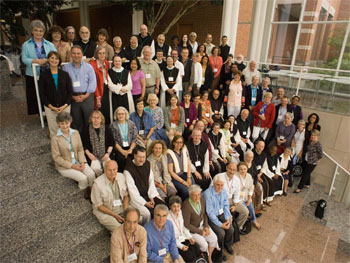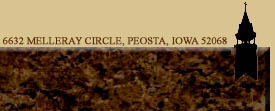The following is an excerpt from a presentation made by Dom Armand Veilleux of Scourmont Abbey in Belgium concerning the advent of "Lay Cistercians" within the Order. The complete article can be found on the website of the International Association of Lay Cistercian Communities. Our own Lay Cistercian community calls itself the Associates of Iowa Cistercians. You can find more about the AIC at their website.
 For a quarter of a century now we have seen developing at the heart of the Cistercian Family a spiritual movement that has gradually come to be called "Lay Cistercians". This movement touches various branches of the great Cistercian Family and from now on it even constitutes an element of this Family. At the General Chapter of Holyoke, in the United States in 1984, a certain Mr. Harvey R. Graveline of New York asked a superior of the Order to present his project of a Secular Trappist Order to the Chapter. This request was mentioned briefly in plenary session toward the end of the Chapter that had been completely taken up with the updating of the Constitutions. Even if no one was interested in a kind of "Third Order", the reaction of the Chapter was rather positive toward the association of lay people with the spiritual life of the communities. It was simply remarked that there was no need to legislate concerning this point and that nothing prevented a community from establishing spiritual ties with a group of lay people. This attitude of the Order is still in practice today. Even if the Order has constantly shown an increasingly positive attitude regarding this spiritual phenomenon, it has up to now refused to legislate about it.
For a quarter of a century now we have seen developing at the heart of the Cistercian Family a spiritual movement that has gradually come to be called "Lay Cistercians". This movement touches various branches of the great Cistercian Family and from now on it even constitutes an element of this Family. At the General Chapter of Holyoke, in the United States in 1984, a certain Mr. Harvey R. Graveline of New York asked a superior of the Order to present his project of a Secular Trappist Order to the Chapter. This request was mentioned briefly in plenary session toward the end of the Chapter that had been completely taken up with the updating of the Constitutions. Even if no one was interested in a kind of "Third Order", the reaction of the Chapter was rather positive toward the association of lay people with the spiritual life of the communities. It was simply remarked that there was no need to legislate concerning this point and that nothing prevented a community from establishing spiritual ties with a group of lay people. This attitude of the Order is still in practice today. Even if the Order has constantly shown an increasingly positive attitude regarding this spiritual phenomenon, it has up to now refused to legislate about it.
The number of lay groups that consider themselves "Cistercian" and the number of persons connected with these groups continues to grow. The question that is raised more and more concerns the advisability of conferring on these groups a specific "official" status within the Order (or the Cistercian Orders?) or within the Church. Before considering the various forms such a recognition could take or, more generally, the various ways in which this movement could evolve, let us trace its history, if only its main features.
This is part of a much larger phenomenon. The post-synodal document published by John Paul II after the synod on the Laity (Christifedeles Laici) has a section (cf. especially N° 29-31) on the importance of such lay communities; and most religious institutes have now some form of lay associates sharing not only in the activities of the community but also – and first of all – in the spiritual life of the community. The Union of Superior Generals (men) and the International Union of Superior Generals (women) in Rome studied this question on several occasions during the last few years. A good analysis of the present evolution, done by Fr. Bruno Secondin, O.Carm, was published in Informationes (the periodical of the Congregation of Religious) in December 1991, and reproduced in French in the Documentation Catholique of May 3, 1992).
Such groups or authentic communities of lay people finding in the Cistercian spirituality the inspiration for their life must be clearly distinguished from the several lay people who individually are frequent visitors of our communities or of guest houses, as well as from the large family of Cistercian scholars who form a wonderful family of their own and the "friends" of this or that ancient Cistercian abbey. It is probably too early and perhaps not necessary for the Order to legislate about this; but should not the Order acknowledge in some way the fact that communities of lay people have adopted the Cistercian spirituality as the source of their spiritual life and are giving a new concrete expression to the Cistercian charism?
Apart from sharing in the spiritual life of the community, these persons/groups, in many cases, want to help the monks or nuns in practical ways, especially in the more and more complex relationships of the community with the outside world, for example in business, financial and legal matters. One is justified to see in that development something totally consonant with the original form of the institution of the lay brothers in the twelfth century and with the original insight of that institution. (Recent historical studies have shown that the lay brothers in the first centuries of the Order played an important role in the material administration of the Cistercian domains, often signing the important legal documents). The question of the "lay brothers' vocation" has never been satisfactorily solved in our Order and will be considered again at this General Chapter. Would it be realistic to think that we can simply return to the situation of thirty years ago? Perhaps this unresolved question can find a solution in two complementary directions, the first one being the use of a well understood pluralism within the communities of the Order (as provided for in our Cst. 14.2) and the other one being the development of such autonomous lay communities living a new expression of the Cistercian charism in the world, in communion with the monastic cloistered Cistercian communities.
Scourmont, Easter Sunday, 2008

 An off-site link
An off-site link An e-mail link
An e-mail link